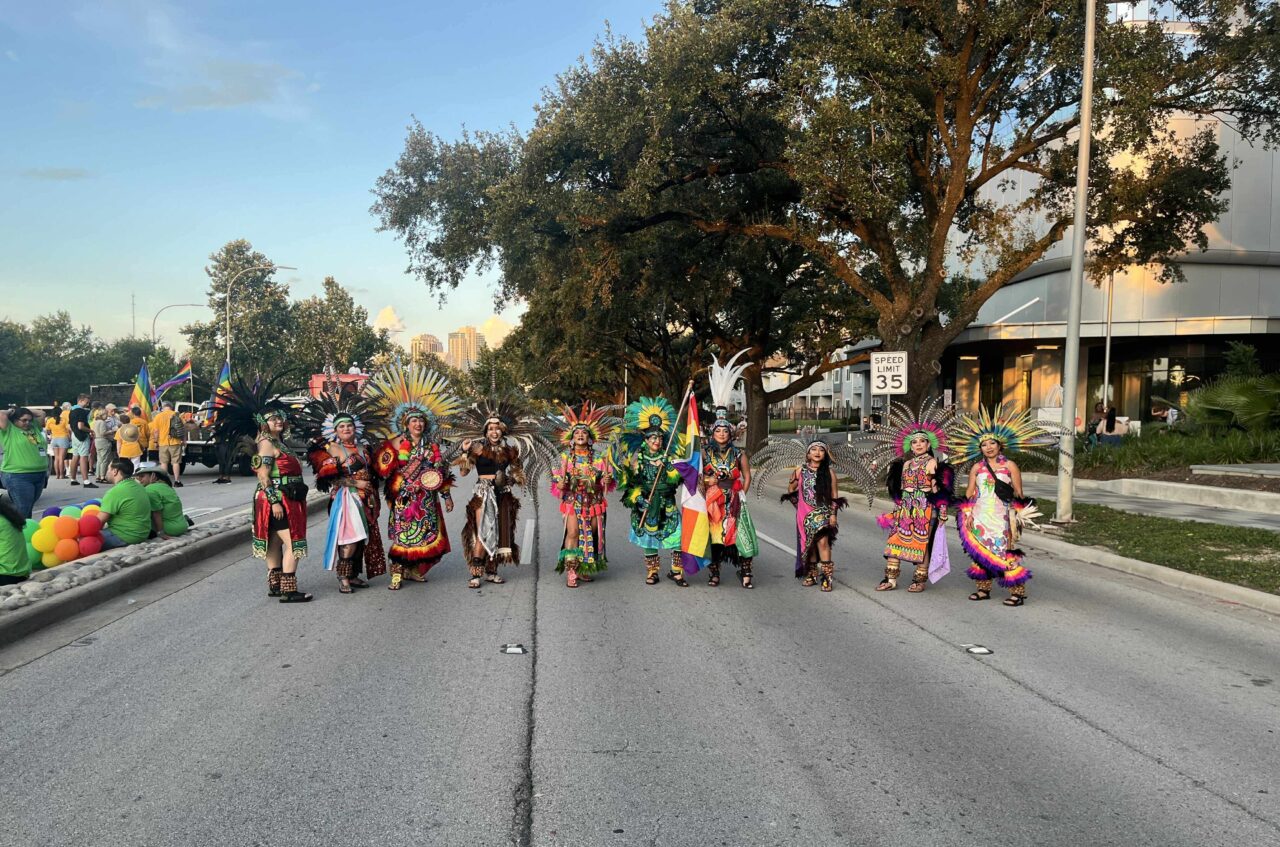✽
Along Allen Parkway, an arterial road leading to Downtown Houston, parade floats line up in a brilliant wash of colors. The disco sounds of Donna Summer blast on someone’s portable speaker as laughter and chatter fill the street. The floats and performers, encompassing the spectrum of the rainbow through flags, sequins, and glitter, are preparing for the Houston Pride Parade, held annually since 1979.
Toward the end of the line, I wait for the parade to start with my fellow danzantes (dancers).
I am here as a queer and transgender anthropologist and a member of Itzcoatl Tezkatlipoka, a calpulli (group or family) that practices danza Azteca. This artistic spiritual practice combines the huehuetl (a three-legged drum made from hollowed-out tree trunks and stretched hide), atuendo (ceremonial regalia), and movement. The songs and dances originated with the Mexica people of Mexico and reach back to as early as 1525 in Tlaxcallan.
The version that we practice today was brought to California in the 1970s as part of the Chicano Movement. Through this contemporary form of danza Azteca, danzantes physically and spiritually engage with Mexica practices as a connection to their own sense of Indigeneity. It has also historically been utilized as a form of protest—a tradition that Itzcoatl Tezkatlipoka continues today.
Offering danza during the Houston Pride Parade is a show of support for the queer and trans community by Latine and Indigenous danzantes. In Texas, queer, trans, and Latine communities are being persecuted through local and federal legislation. Just days before the 2025 Pride Parade in June, two bills passed by the Texas House legislature set age restrictions for trans mental health care and put in place strict definitions of biological sex. In response to these and other threats, some trans youth and their parents are considering leaving the state to attain gender-affirming health care.
Since early 2025, President Donald Trump’s administration has also targeted Houston’s Latine population as part of their goal of mass deportations. According to the Deportation Data Project, Texas reported over 25,000 arrests in the first five months of the year—making up almost a quarter of all Immigration and Custom Enforcement (ICE) arrests in the U.S.
Amid such threats facing our communities, Itzcoatl Tezkatlipoka has been invited to join FLAS (Fundación Latinoamericana De Acción Social) on their float. They are a Houston-based organization that offers social services such as HIV/STD testing and substance use and behavioral health treatment. As we wait for the parade to start, we adjust the feathers in our copillis (feather headdresses), tighten the laces of our ayoyotes (ankle rattles made from seedpods), and smile for photographs with passersby.
Despite the fear and oppression, we are here.
DANZA AZTECA AS A FORM OF PROTEST
Prior to Spanish colonization of Anahuac (the Valley of Mexico), Mexica people relied on danza Azteca as a form of prayer, education, and community. However, in 1519, Spanish colonizers began eradicating Mexica communities and practices. People who danced had their feet cut off. Those who played the huehuetl lost their hands. People who spoke or sang in Nahuatl lost their tongues. In the face of these threats, danza Azteca turned into an act of resistance to maintain traditions, history, and sciences.
“I love that—knowing that our lineage comes from those revolutionaries,” a fellow Itzcoatl Tezkatlipoka danzante and traditional tattu (tattoo) artist Xixi Xa told me in an interview. “The danzas themselves got saved, through memory, through writing these things inside of the drum[s].”

